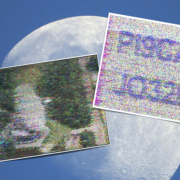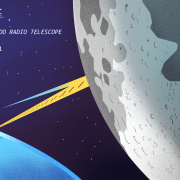Dwingeloo Telescope receives Moon echoes for Scouting Jamboree
Last Friday and Saturday evening 6 and 7 September 2019, Michel Arts (PE1NVK) and Simon Bijlsma (PA7SB) operated the Dwingeloo telescope to make it act as an ‘Earth Moon Earth’ (EME) relay station for scouting groups who wanted to try out their self-built antennas in preparation for the coming ‘Jamboree On The Air’ (JOTA) on Friday 18 and Saturday 19 October 2019. The Dwingeloo telescope is very suitable for receiving the extremely weak EME signals due to its enormous sensitivity. The signals received are being streamed over the internet via the webSDR developed by Pieter-Tjerk de Boer (PA3FWM).
Eleven years ago this JOTA-EME project was initiated by Frans de Jong (PE1RXJ) who wrote a building description for the required ‘23 elements Long-Yagi antenna for the 70cm band ‘ (in Dutch but with drawings and photos).
On Friday, Frans successfully tested their antennas at the scouting group in Veldhoven and Bart Laarkamp (PD1BCL) at the group in Zutphen. On Saturday Michiel Vonk (PB0MV) from the Scouting group in Uitgeest, together with his father (Fred PE1PAB) and brother (Jeroen PA2JV) was active from Reeuwijk. Peter Ravestein (PE1NLU) was active with a group from Breda. In Eindhoven, scouts watched the broadcasts of the other groups via the webSDR. Unfortunately, both Michiel and Peter, apart from sending the numbers ’73’, the radio amateur code for ‘warm greetings’, failed to make a complete two way connection. The transceiver Michiel had borrowed did not have a TCXO and therefore it’s frequency was drifting. Accidentally he also forgot to adjust the software from HF to UHF with the nescessary 2.5 seconds EME delay time. This has shown that setting up and using the WSJT-X decoder software, designed by Nobel Prize winner Joseph Taylor (K1JT), for the first time is no mean feat. Michel and Simon also had to struggle with the software settings in previous years to be able to decode the signals that we offer via the webSDR. The settings, also the audio level, listen very closely because of the extremely weak moon echo signals that the scouts send with their antennas. However, if it works, the results are great! The software is so sensitive that signals up to -30dB (1/1000) can be detected under the noisefloor. This is so faint that you hear nothing at all by ear, just noise and you hardly see anything in the ‘Fast Fourier Transform’ (FFT) waterfall screen (see photo below).
During the successful test broadcasts from Frans and Bart, their signals in the different passages were between -28dB and -16dB under the noisefloor. These differences in strength were caused by the fact that the antenna must always be aligned with the moon. However, due to the clouds, the moon was often not visible on Saturday evening, and therefore making manual alignment was a difficult job. Just ‘forgetting’ to adjust the antenna for five or ten minutes means that the signal is received much weaker in Dwingeloo. See for this the explanation with the building description of Frans.
Interesting to see was that in addition to the moon echoes, reflections were also seen against aircraft and the ionosphere. Bart in Zutphen had once directed his antenna straight to Dwingeloo and then the + 6dB signal, that is strongly audible, came through. Because there was no delay time (delay time ‘DT’) in the signal, this was clearly distinguishable from the real moon echoes because those signals are received with a delay of approximately 2.5 seconds. The distance from the earth to the moon is more than 385,000 km and you can therefore calculate that, with the speed of light, the echo time is approximately 2.5 seconds.
With this blog post we hope to interest other scouts or radio amateurs who support scouting groups during the JOTA to also watch the activities of the JOTA groups that are working on EME via our webSDR. And hopefully they become so enthusiastic that they will participate next year with their own built antennas. To be able to watch, it is necessary to install WSJT-X and inject the audio from the webSDR into the WSJT-X software via a sound mixer or ‘virtual cable’ so that the JT65 mode B signals can be decoded. Of course we also invite other interested parties to try this with their PC or laptop.




 Sofie Shen
Sofie Shen





 Cees Bassa
Cees Bassa